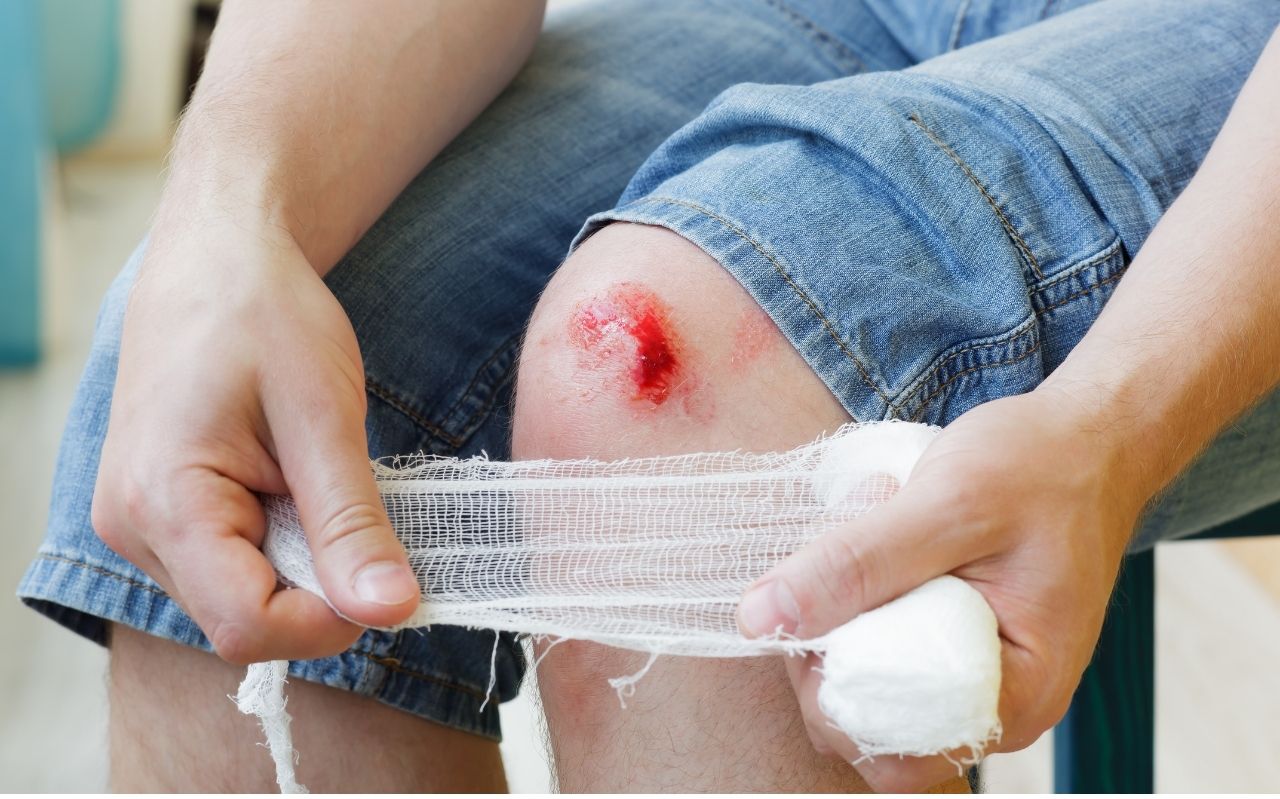Wound healing is a multiphase process in which several regenerative and repair processes are activated in the body. To some extent, it occurs naturally due to components of the immune system and a combination of collagen and elastin.
However, wound healing can be accelerated or the resulting effect of the scar can be improved. After proper healing, the skin regains its protective function.
The process of skin renewal after wound formation
Skin renewal and healing takes place in four phases, which necessarily follow each other and are therefore also referred to as a cascade of healing reactions.
Phase 1 – Hemostasis
Hemostasis (cessation of bleeding) occurs immediately after skin injury and aims to prevent major blood loss. In the initial phase, platelets interact with collagen and the process of blood clotting (aggregation) begins. The most important role is played by the enzyme thrombin, which forms a fibrin mass and subsequently forms a blood clot.
Phase 2 – Inflammatory (cleansing) phase
During this period, the cells of the immunity system – specifically white blood cells (neutrophils) – try to actively remove bacteria and pus . Their highest concentration is 24-48 hours after skin injury. The wound is then cleansed by macrophages – cells of the immune system , which can destroy foreign substances (pathogens), but also broken cells. During wound cleansing, macrophages produce growth factor and specific proteins that accelerate the formation of new tissue. The inflammatory phase is manifested by redness, swelling, and a feeling of warmth at the site of injury.
Phase 3 – Proliferation phase
After cleansing, the wound begins to contract, the edges of the wound unify and new tissue is epithelialized. The proliferative phase has a different duration depending on the size of the wound, the type of skin and the treatment of the wound, on average it lasts from 4 to 24 days.
Phase 4 – Maturation (scar maturation)
The last phase, in which the formation of new tissue is completed by reorganizing the newly formed collagen fibers into new units . As in the proliferation phase, its length is variable and depends mainly on the size and location of the wound, but also on the subsequent care of it. In some people, collagen is naturally found in sufficient quantities, in others, on the contrary, we encounter the formation of keloid scars, which are more difficult to heal.
How to properly treat a wound and help it heal better
The first step in caring for a wound of any size is disinfecting it and cleaning it regularly . You should disinfect the wound for the first time immediately after the injury. If mechanical contaminants such as gravel, sand or other small particles are present, they must be washed under running water. Then disinfect the wound (Betadine, Detol, Septonex).
Cover the open wound (bandage, gauze, bandage). You should bandage or tap the wound at least every 24 hours or whenever it is wet. Oxygen supply is also essential for wound healing, which is important in all phases of wound healing. You can leave the wound exposed in a clean environment, for example during the night at home.
You can then use various healing herbs or ointments to support wound healing.
Promoting wound healing by natural methods
Nature provides us with a number of its fruits that have disinfectant and antibacterial effects . To support wound healing, you can use:
Rapeseed
Rapeseed decoction is suitable for disinfecting wounds, it is also suitable for treating injured skin in small children. You can also use the decoction of the rape directly after removing the stitches. You can also use rapeseed ointment, which supports wound healing and epithelialization.
Chamomile
It has a number of beneficial ingredients, bisabolol (antibacterial effects) and azulene (epithelializing effects) are the most effective in wounds. Chamomile can be applied to wounds in the form of decoction, oil, ointment or dressing.
Scorocel copy
It forms a layer of mucilaginous surface on the wound, which is especially suitable for the wet type of wound healing. It has anti-inflammatory, antibacterial and astringent effects. Broths are used to make decoctions, ointments, creams or tinctures.
Mountain arnica
Arnica has the ability to regenerate tissue, helps absorb hematomas and also improves the healing of difficult-to-heal wounds. It is most often used in the form of tinctures, gels, compresses.
White lily
The most used home tincture for wound healing is made of white lily . Lily tincture helps remove pus from the wound and heals wounds, has antibacterial, antifungal, astringent effects. The most effective substance in lilies is the flavonoid kempferol.
Ordinary ranking
The ladder has been used to accelerate wound healing since the days of ancient Greece. However, it has several drug interactions and should therefore be avoided by people taking medicines to lower blood pressure, thin the blood or lithium.
Aloe vera
Aloe vera (for example in the form of a gel) contains a number of minerals and vitamins that help the skin regenerate. It has antioxidant properties and prevents the formation of ulcers and inflammation on the skin. The active substance is glucomannan, which increases collagen production.
Coconut oil
Monolaurin , one of the substances in coconut oil, has antimicrobial properties and can be used to accelerate wound healing.
Ointments, creams and nutritional supplements accelerating wound healing
Ointments and creams – when used on a wound, they have two functions: disinfectant and antibacterial (silver salts) or to promote healing (panthenol, hyaluronic acid).
Antiseptic non-stick dressing (patches) also suitable for the treatment of infected wounds. They have a broad antimicrobial spectrum.
Of the nutritional supplements, it is suitable to use, for example, enzymes, collagen or vitamin C during wound healing .
Conclusion
The wound healing process is complex and involves several mechanisms. Their disorders at various levels can cause poorly healing, chronic wounds. With proper wound care, we can accelerate healing processes and prevent secondary bacterial infection. Various herbs have been used for a long time to heal wounds, and ointments and creams from the pharmacy are also effective.
Also Read : Should I Dye My Hair After 50-55 Years Old?




